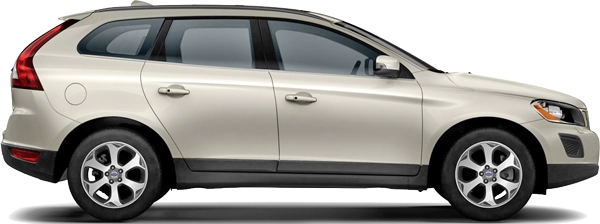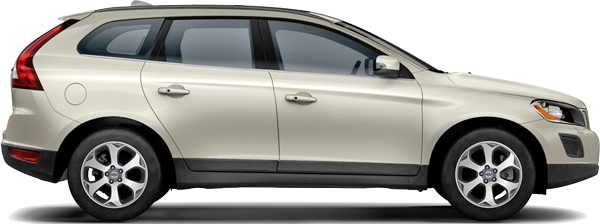The Comparative Analysis :
Mercedes EQC 400 4MATIC (19 - ..) vs. Volvo XC60 D4 AWD Geartronic (12 - 13)
€ 71,300

€ 40,400

€ 71,300
Base Price ⓘBase price of a new vehicle with standard equipment in Germany at market launch.
€ 40,400
ⓘBase price of a new vehicle with standard equipment in Germany at market launch. Price Info
Vehicle Dimensions
The dimensions of these vehicles differ considerably. The Mercedes EQC 400 is 5.3 inches longer, 0.3 inches narrower and 3.5 inches lower than the Volvo XC60 D4.
Mercedes EQC 400
Volvo XC60 D4
63.9
74.2
82.5
67.4
74.4
83.5
74.2 in
Width
74.4 in
82.5 in
Width Incl. Mirrors
83.5 in
63.9 in
Height
67.4 in
113.1
187.5
109.2
182.2
187.5 in
Length
182.2 in
113.1 in
Wheelbase
109.2 in
Vehicle Weight
Mercedes EQC 400
Volvo XC60 D4
5501 lb
Curb Weight
4279 lb
6482 lb
Gross Vehicle
Weight
Weight
5523 lb

Weight Difference:
1221 lb
22.2 %

General
Mercedes EQC 400
Volvo XC60 D4
N293
Generation
D
Sport Utility Vehicle
Car Body Style
Sport Utility Vehicle
Electricity
Fuel Type
Diesel

Permanent all-wheel drive (AWD)
Drivetrain
Permanent all-wheel drive (AWD)

1-speed automatic transmission
Transmission
6-speed automatic transmission
Engine
Mercedes EQC 400
Volvo XC60 D4
Asynchronous motor
Engine Type
Straight-five diesel engine with turbocharger
Engine Code
D5244T5
0
Valves
4
0
Cylinders
5
0 L / 0 cu in
Displacement
2.4 L / 117 cu in
402 hp
at 0 rpm
Power
161 hp
at 4000 rpm
Mercedes EQC 400
402 hp
161 hp
Volvo XC60 D4
561 lb‑ft
at 0 rpm
Max. Torque
310 lb‑ft
at 1500 rpm
Mercedes EQC 400
561 lb‑ft
310 lb‑ft
Volvo XC60 D4
Performance
Mercedes EQC 400
Volvo XC60 D4
112 mph
Maximum Speed
118 mph
5.1 sec
Acceleration 0 to 62 mph
10.9 sec
62 mph
62
mph
mph
233 ft
0.000 sec

Mercedes EQC 400
62 mph
62
mph
mph
495 ft
0.000 sec

Volvo XC60 D4
▶ REPLAY
13.68 lb/hp
Weight-to-Power Ratio
26.58 lb/hp
Mercedes EQC 400
13.68 lb/hp
26.58 lb/hp
Volvo XC60 D4
Fuel Economy / Emissions
Mercedes EQC 400
Volvo XC60 D4
Fuel Economy
32 kWh✽
( 105 MPGe ⓘ Miles per gallon gasoline equivalent (MPGe) is a measure of the average distance traveled per unit of energy consumed. MPGe, specified in miles per U.S. gallon, is used to compare the energy consumption of vehicles that use different energy sources.)
combined ✽ per 100 miles
35 mpg
( 39 MPGe ⓘ Miles per gallon gasoline equivalent (MPGe) is a measure of the average distance traveled per unit of energy consumed. MPGe, specified in miles per U.S. gallon, is used to compare the energy consumption of vehicles that use different energy sources.)
Mercedes EQC 400
105 MPGe
39 MPGe
Volvo XC60 D4
No data
city
26 mpg
No data
highway
42 mpg
80 kWh
Fuel Tank Capacity
18.5 gal
252 mi
Range
639 mi
Mercedes EQC 400
252 mi
639 mi
Volvo XC60 D4
Environmental Impact
64.1 kWh
Total Energy Consumption
per 100 miles ⓘThe total energy consumption per 100 miles is the amount of energy consumed by a vehicle when burning fuel or using electricity per 100 miles (final energy), and the energy required to produce the appropriate amount of fuel or electricity (primary energy).
per 100 miles ⓘThe total energy consumption per 100 miles is the amount of energy consumed by a vehicle when burning fuel or using electricity per 100 miles (final energy), and the energy required to produce the appropriate amount of fuel or electricity (primary energy).
139.9 kWh
Mercedes EQC 400
64.1 kWh
139.9 kWh
Volvo XC60 D4
Elektrofahrzeug
Emission Standard
Euro 5
0 g/mi (WLTP)
CO2 Emissions
288 g/mi (NEFZ)
Practical Convenience
Mercedes EQC 400
Volvo XC60 D4
5
Doors
5
5
No. of Seats
5
981 lb
Maximum Payload
1243 lb
14.2 cu ft
Trunk Volume
14 cu ft










41.3 cu ft
Cargo Volume (Seats Down)
41.2 cu ft















